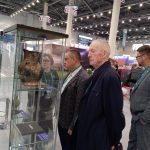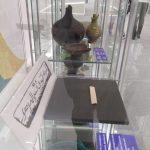Exhibition “Monuments of Muslim medieval culture: the mausoleum of the Kazan Khans and the Lapas mausoleum complex” at the Islamic Forum-2025
On May 14, 2025, as part of the Russia–OIC International Economic Forum “KazanForum2025,” the exhibition “Monuments of Muslim medieval culture: the mausoleum of the Kazan Khans and the Lapas mausoleum complex,” organized by the Institute of Archaeology named after A.Kh. Khalikov of the Tatarstan Academy of Sciences, opened at the stand of the academy.
The study of Muslim archaeological sites holds a special place among the Institute’s expeditions and research programs. The exhibition showcases unique archaeological discoveries unearthed during excavations in the Astrakhan region at one of Russia’s most remarkable monuments from the Islamic period of the Golden Horde (XIII–XIV centuries): mausoleums built by Uzbek Khan over the burial sites of his illustrious ancestors. During Uzbek Khan’s reign, Islam became the state religion of the Golden Horde, sparking a cultural renaissance and extensive construction. The findings enabled archaeologists and architects to reconstruct the mausoleum using geoinformation technologies and geophysics, assess its monumental scale, and situate it within the architectural traditions of Islamic culture. Visitors explored a 3D- reconstruction of the mausoleum displayed on the stand’s screen.
The exhibit cases featured tile lintels with over 20 distinct decorative patterns, all crafted using the same technique and style, a squinch fragment from the mausoleum, and tiles (likely from its façade). These artifacts, dating to the Golden Horde era, reflect the spread of Islam into the cultural and spiritual life of the region’s peoples.
Continuity in architectural traditions is evident in materials similar to those from the mausoleum of the Kazan Khans, such as fragments of turquoise-glazed kashin ceramics and a façade plate fragment that once held mosaic tiles. These Golden Horde era kashin ceramic pieces were discovered during excavations of the mausoleum of the Kazan Khans at the Kazan Kremlin.
Other exhibits include a 16th-century girih (geometric patterned tile), 15th–16th-century kumgans (a pitcher for carrying and pouring water), jugs, kubyshkas (a ceramic jar or pot), a unique 10th–11th-century bone plate, and a Golden Horde-era gulyabdan (a special type of dishware in which rose oil used to be stored for washing hands after a meal).
The exhibition will be open until the end of the forum at the KazanExpo exhibition pavilion.






